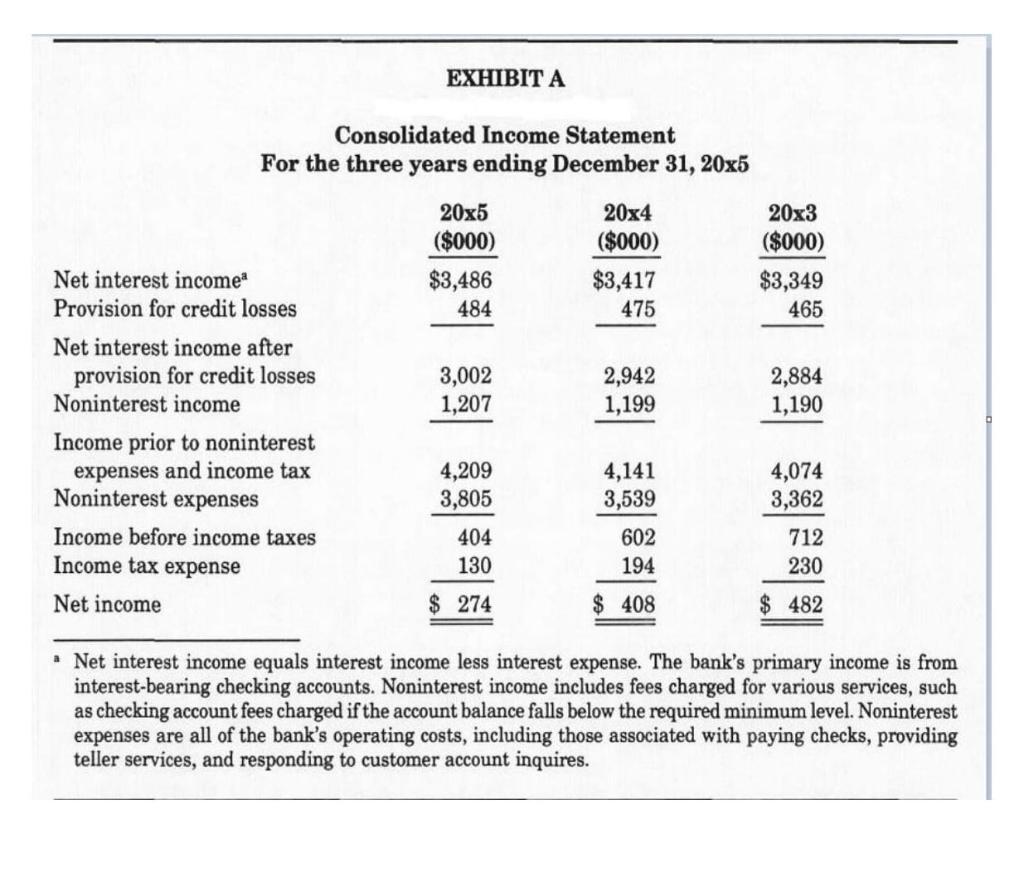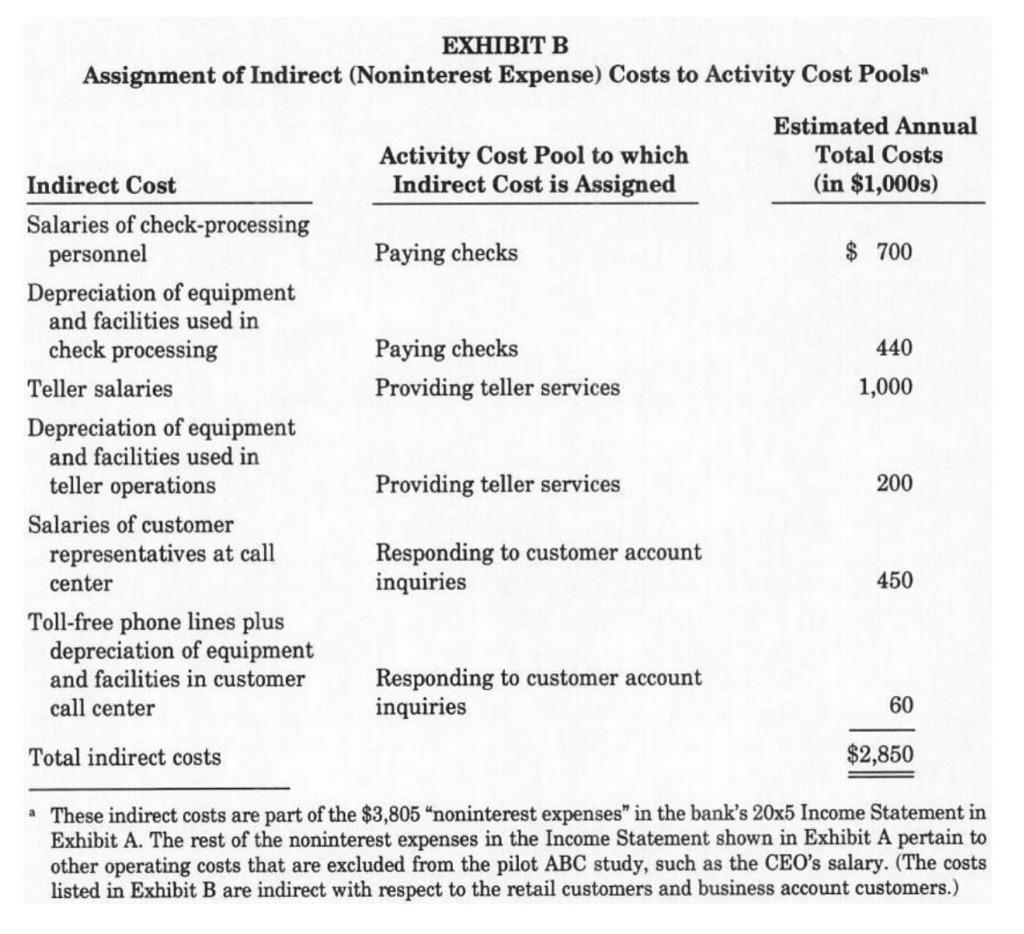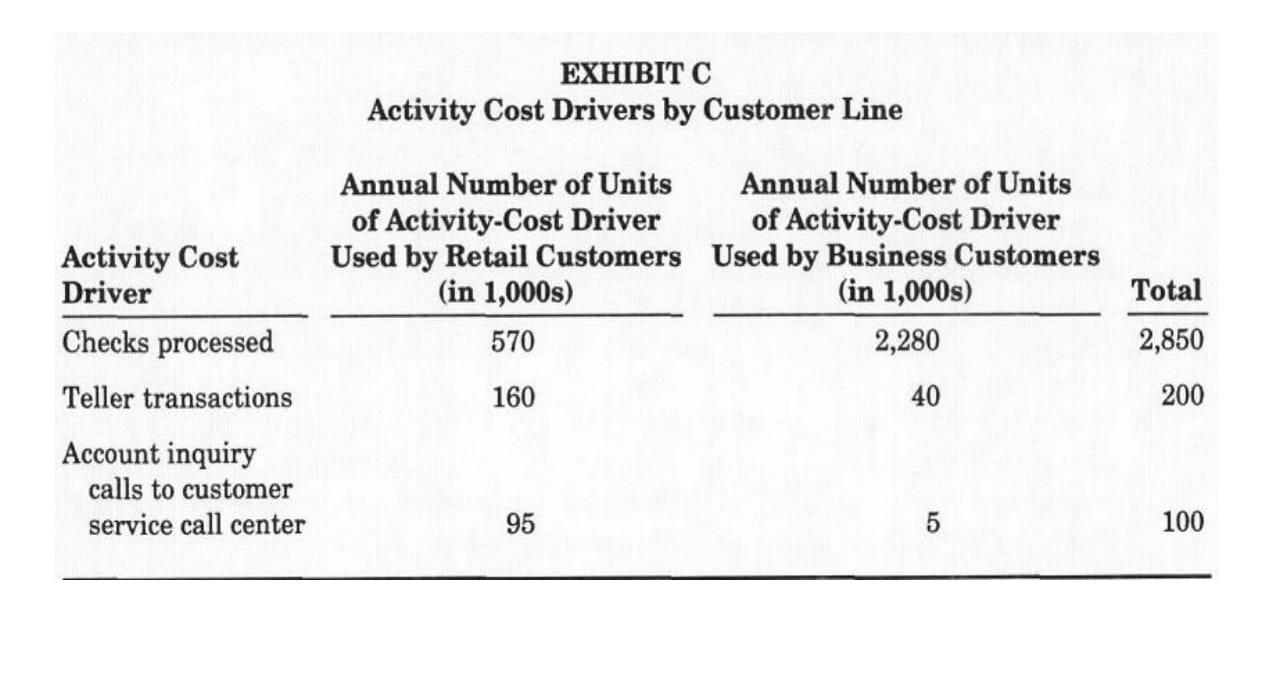Question
The ABC Bank The ABC Bank began operations in the mid-1980s. The bank quickly grew by providing checking account services to many small businesses. Although
The ABC Bank
The ABC Bank began operations in the mid-1980s. The bank quickly grew by providing checking account services to many small businesses. Although ABC initially offered checking account services for individual accounts (retail customers), the bank primarily focused on serving its business customers. During the economic slowdown of the early 1990s that weakened the local economy, growth in business customer accounts began to decline. In response, ABC's senior management adopted a new strategy, focusing on increasing the number of retail customer accounts. By aggressively marketing individual retail accounts, the ABC Bank continued to grow. Today, the ABC Bank strives to maintain a stable base of business customers, while actively competing for an increased market share of retail customers.
Recent income statements (Exhibit A) reveal a decline in the
bank's profits. The bank's primary (noninterest) expense consists of
salaries and employee benefits. Most full-time employees' first priority is
providing services to customers; these employees conduct their
administrative responsibilities during slack times. The Bank schedules
additional part-time employees to work during peak demand times, from
11AM- 2PM and Friday afternoons. Flexibility in scheduling part-time
employees means that the bank's staff is lean and fully utilized. ABC's
CEO, Rob Garrison, believes that this staffing arrangement allows the bank to provide speedy customer service, while operating at practical capacity. (That is, the bank's staff is fully utilized in efficient operations, after allowing for bank holidays and other scheduled staff activities such as training.)
To counter falling profits, ABC's directors took two actions last year, both aimed at increasing the bank's retail customer base. First, ABC established a service call center to respond to customer inquiries about account balances, checks cleared, fees charged, and other banking concerns. Second, ABC's directors authorized year-end bonuses to branch managers who met their branch's target increase in the number of customers. However, even though 80 percent of the branch managers met the targeted increase in customer accounts, the Bank's profits continued to decline. CEO Rob Garrison does not understand why profits are declining, given that the Bank is serving more customers. ABC's southeast regional manager, Erik Larsen, has also noticed that while small retail customers flock to the bank, the number of business customers is barely stable.
Erik Larsen suspects that ABC's costing system may be part
of the problem. ABC developed its simple costing system when the
bank began operations in 1985. The bank does not trace any costs directly to individual customers. It simply treats all (noninterest expense) operating costs identified in the Income Statement in Exhibit A as indirect with respect to the customer line. The bank allocates these indirect costs to either the retail customer line or the business customer line, based on the total dollar value of checks processed (which is readily available because each branch must provide the dollar values of daily transactions for internal control). For the current period, ABC processed a total of $95 million in checks, of which $9.5 million was written by retail customers, and $85.5 million was written by business customers. This costing approach was fairly typical of banks and other financial institutions at the time ABC developed its cost system.
In college, Erik learned about an alternative costing approach called activity-based costing (ABC). However, the examples he remembered involved manufacturing firms. He wondered whether ABC could develop an ABC system, with the business account customer line and the retail account customer line as the two primary cost objects. Erik approached Rob Garrison with this suggestion. Rob was skeptical, exclaiming, "Our profits are going down the tubes and you want me to spend money developing a new accounting system?" However, Erik persisted, and Rob eventually authorized a pilot ABC study using three local branches of the bank.
The ABC implementation team included Erik, the managers of each of the three bank branches, a bank teller, and a representative from the customer service call center. The team began by identifying the activities ABC Bank performed. To start a simple pilot study, the team identified the three most important activities:
-
Paying checks
-
Providing teller services
-
Responding to customer account inquiries at the customer service call
center
If this pilot study turned out to be successful, then the team planned to refine the system by conducting a more detailed activity analysis the following year.
The ABC team began by determining the costs that are associated with each of the three activities. The team quickly discovered that, as is typical in service industries like banking, labor (personnel) costs dominate. The ABC team asked each employee to fill out a short questionnaire to find out how the employee spends his or her time. The team then followed up with an in-depth personal interview with each employee. The ABC team used this combined information to estimate the percentage of time each employee spent on each of the three activities: (1) paying checks, (2) providing teller services, and (3) responding to customer account inquiries.
The team then estimated the other (non-labor) resources that each of the three activities consumed. For example, they traced to the "responding to customer account inquiry" activity: (1) the cost of toll-free telephone lines at the customer service call center, and (2) depreciation on other equipment and facilities the call center personnel use. Similarly, the ABC team estimated the percentage of time the bank's information system was used for check processing and providing teller services (vs. other uses such as compiling periodic financial statements), to determine how much of the equipment's depreciation to assign to the activities "paying checks" and "providing teller services."
To complete the pilot study in a timely fashion, the ABC team based their estimated activity costs on last year's actual data, which were already available. If the pilot study succeeded, then the ABC team planned to develop budgeted indirect cost rates for each activity the following year. The advantage of budgeted rates over actual rates based on the prior year's data is that budgeted rates (budgeted cost associated with the activity divided by the budgeted quantity of the activity's cost driver) can incorporate expected changes in costs and operations.
After examining the three branch banks' indirect costs (that is,
the cost items making up the branch banks' noninterest operating
expenses), the ABC team classified the annual costs in each activity's
cost pool1 (hereafter, all numbers are in thousands) as shown in Exhibit B.
The team identified the following cost drivers2 for each activity cost pool:
6
Activity Cost Pool
Paying checks Providing teller services Responding to customer account inquiries
Activity Cost Driver
Number of checks
Number of teller transactions Number of account inquiry calls to customer service call center
The ABC team estimated that for the three pilot-test bank branches, the retail and business customer lines experienced the annual activity levels (in thousands) as shown in Exhibit C. For example, Exhibit C reveals that retail customers had 160,000 teller transactions and made 95,000 account inquiry calls to the customer service call center.
ABC Bank currently services 150,000 retail customer checking accounts and 50,000 business customer checking accounts. The bank earns net interest revenue on the balances that customers keep in their
1An activity's cost pool is simply a grouping, or aggregation, of all the individual costs associated with that activity. The bank's ABC team created separate activity cost pools for the costs associated with each of the three activities: (1) paying checks, (2) providing teller services, and (3) responding to customer account inquiries.
2 A cost driver is a factor, such as the number of checks processed, that causally affects costs. For example, the costs associated with the activity "paying checks" rise and fall as the quantity of the cost driver (the number of checks processed) rises and falls.
checking accounts.3 On average, the bank earns the following annual revenue from each type of account: Avg. annual revenue per retail customer account $10
Avg. annual revenue per business customer account $40
7
3 The bank earns net interest revenue by managing the "interest rate spread." This spread is the difference between the interest rate the bank earns on customer deposits (say 8 percent), less the interest rate the bank pays the customer on the average checking account balance (say 4 percent).
Required:
1. Compute the profit (loss) per customer for the retail customer and business customer first using original cost system then using the ABC System. Use the cost data in Exhibit B.
2. Based on the case, do you think the original cost system is broken? And if your answer is yes, explain why. How can it be improved?
3. How can ABC data be used to develop marketing strategies that increase profits? How can the branch manager use ABC data to identify opportunities to trim cost while maintaining or increasing customer satisfaction?
4. Do you think banks incentive bonus plan to increase the number of customers is wise? What changes, if any, would you recommend?



Step by Step Solution
There are 3 Steps involved in it
Step: 1

Get Instant Access to Expert-Tailored Solutions
See step-by-step solutions with expert insights and AI powered tools for academic success
Step: 2

Step: 3

Ace Your Homework with AI
Get the answers you need in no time with our AI-driven, step-by-step assistance
Get Started


